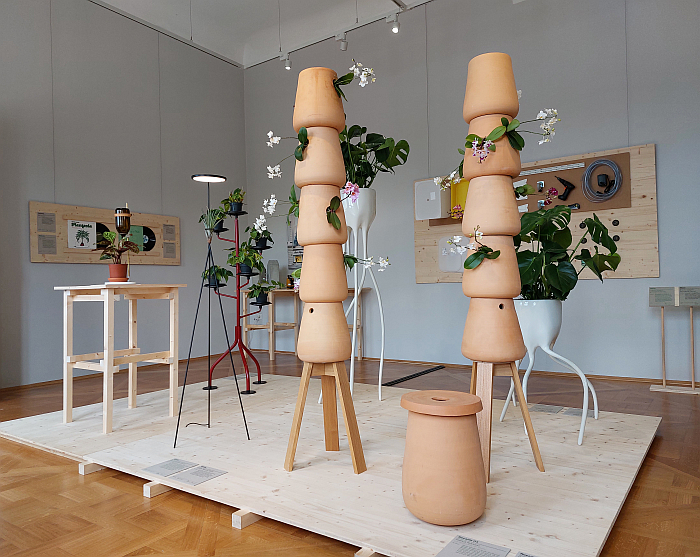Plant Fever. Towards a Phyto-centred design at Schloss Pillnitz, Dresden
While the Art Nouveau of the late 19th/early 20th centuries was without question inspired and informed by nature, for all by plants, one thinks, for example of the many representations of alliums, liliums, vitaceae et al, it was a moment that was led by humans, and for all one that placed human needs, human demands, human comforts at its core. Certainly above the needs, demands, comforts of plants.
With the exhibition Plant Fever. Towards a phyto-centred design Schloss Pillnitz, Dresden, or more specifically the Kunstgewerbemuseum Dresden and the Staatliche Schlösser, Burgen und Gärten Sachsen, SBG, the contemporary residents of Schloss Pillnitz, consider alternative expressions of inspiration and information, alternative human-plant relationships…….
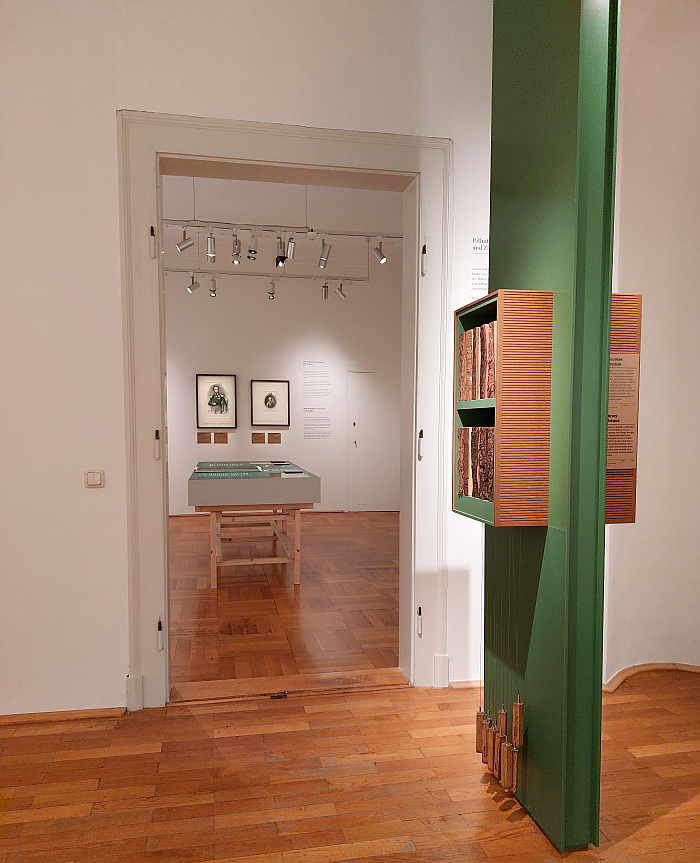
Plants as Passion, as seen at Plant Fever. Towards a Phyto-centred design, Schloss Pillnitz, Dresden
Although it can trace its (hi)story back to the 14th century, in its contemporary guise Schloss Pillnitz is, essentially, a child of the early 18th century when the, then, Sächsische Kurfürst August der Starke began its transformation into a baroque Lustschloss, essentially a party castle, a summer party castle, including overseeing construction of both the Wasserpalais that frames and defines the Elbe facing side of the estate with its grandiose steps into the river to receive the gondolas bringing the royal party and their guests from Dresden and environs, and the Bergpalais, a much more reserved, if no less grand and overtly ostentatious affair. Following August’s death in 1733 Pillnitz remained a favoured Schloss amongst the Sächsische nobility, and his successors continually developed the estate; sometimes voluntarily, sometimes involuntarily such as, for example, following the major fire of 1818 that led to the construction of the Neue Palais between Bergpalais and Wasserpalais and thus the completion of the architectural triptych that greets visitors today.
In addition to continually developing the built environment at Pillnitz, successive generations of Sächsische royals also continually and studiously developed the park and gardens: the original park, and the long-established Lustgarten, pleasure garden, between Bergpalais and Wasserpalais, being joined over the decades by, and amongst other additions, an “English” garden, a “Chinese” garden and in 1859 by a very contemporary glass and cast iron palm house which at that time was, by all accounts, one of the largest of its kind.
Then, as so oft in the (hi)story of the contemporary Germany, came the abolition of the monarchy in 1918 and the thereby resulting abdication of Friedrich August III as the last King of Sachsen; and while the (hi)story of Schloss Pillnitz clearly doesn’t end in 1918, our abridged telling of its (hi)story does. Save to note that today Schloss Pillnitz is managed and operated, in effect, by the State of Sachsen, via the sprightly monickered arms length company Staatliche Schlösser, Burgen und Gärten Sachsen, SBG, and is also home to the Kunstgewerbemuseum Dresden.
Two organisations, two contemporary residents of Schloss Pillnitz, who have joined forces to produce Plant Fever. Towards a Phyto-centred design. Or perhaps more accurately, have joined forces to expand and develop Plant Fever. Towards a Phyto-centred design, an exhibtion originally produced and staged in 2019 by CID – centre d’innovation et de design au Grand-Hornu, Belgium, as a single exhibition, but which in Dresden exists as a trio of showcases.
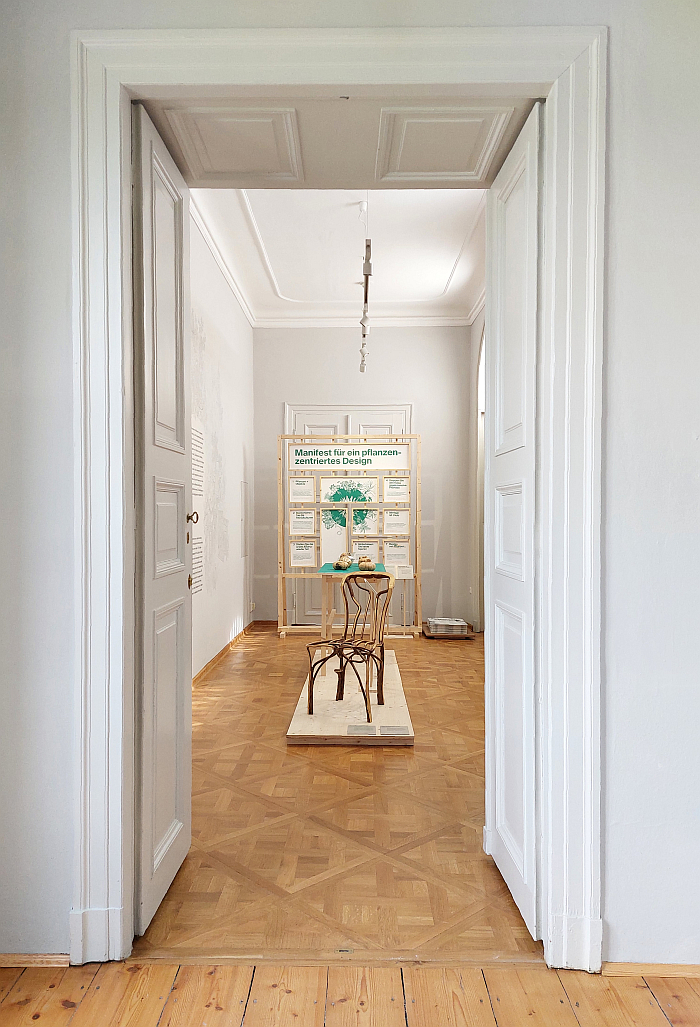
Studio d-o-t-s Manifesto for a Phyto-centred Design and The Edwardes Chair by Full Grown, essentially a tree grown as a chair thereby avoiding a lot of the carpentry and joinery, as seen at Plant Fever. Towards a Phyto-centred design, Schloss Pillnitz, Dresden
The first staged in the Kunstgewerbemuseum’s residence in the Wasserpalais and which is the original CID showcase: a presentation of some 50 international projects ranging from the practical to the conceptual, from the functional to the speculative, from the artistic to the scientific, and which in the course of three succinct chapters explore Plants as Resources, more accurately plants as long exploited, misused, abused, resources and recent attempts to develop more equitable relationships with organisms we need for, well, pretty near everything; Plants as Allies, if one so will a move beyond appreciations of plants as passive resources to appreciations of plants as active contributors, active partners, a move that also involves reflections on the rapidly developing discipline of plant neurobiology, those fascinating investigations into plants as sentient beings capable of communicating, thinking, deciding; and Plants as Pets……. Which, no, isn’t weird. Rather is a chapter centred around considerations on what the curators argue is a shift in the status of plants in recent decades from a primarily decorative, ornamental, role in homes and offices, to becoming our co-habitees, companions, colleagues, occasionally our therapists, much as any pet is.
The second showcase curated and organised by SBG, and staged in the neighbouring Neue Palais under the title Plants as Passion, explores and elucidates the long and important, and informative, botanical, horticultural, (hi)story of Schloss Pillnitz, for all as represented and embodied by the botanical, horticultural, research, the botanical, horticultural, passions, of the Sächsische Kings Friedrich August I and Friedrich August II who in the period between ca. 1780 and 1865 were fundamental in the above noted additions to the Schloss’s park and gardens and their thereby transformation from a primarily Baroque pleasure garden to a location of contemporary botanical, horticultural, research. A transformation, and botanical, horticultural, research, which, as Plant Fever ably demonstrates meant that in the decades either side of 1800 Schloss Pillnitz was not only widely networked with similar institutions across Europe, including fellow royal gardens in, for example, Vienna, Hannover or London, and public gardens in, for example, Paris, Ljubjana or Florence, but for all played an important role in the maintenance of those networks and in the dissemination of the insights won. An importance of the Schloss Pillnitz gardens in the development of botany and horticulture in Europe that, as the curators note, saw Dresden become in the course of the 19th century one of Europe’s leading horticultural centres; Plants as Passion noting that around 1900 there were some 600 nurseries in Dresden, which is a phenomenal number, for all when one thinks that the greater majority of Dresden’s, then, citizens would have had no need for plants and shrubs as they battled through the brutal social and economic realities of the period. But does fit in with Dresden’s leading role in the development of the very phyto-centric Jugendstil. And also possess the fascinating question, where did they go, and when, and what remains?
And Schloss Pillnitz gardens that are the third showcase of the Plant Fever triumvirate: a showcase that not only presents a great many physical embodiments of that presented elsewhere in Plant Fever as concept, argument, data, documentation etc, but gardens which offer space and impulse for reflection and consideration on that viewed in the other two showcases.
Not least for reflection and consideration on the deliberately, and deliciously, double-edged title: on the one hand Fever as in excitement, mania, frenzy; on the other Fever as in sick, unwell, pyrexia.
The former echoing from our contemporary age with its increasing appreciations of, and its eager, restless, spirited research into plants as allies, resources and pets, back to the 18th and 19th centuries, back to the passions of Friedrich Augusts I and II and their many contemporaries.
The latter understood not just in context of the contemporary malaise afflicting the wider environment, nor only in terms of the many plant species threatened with extinction on account of human society’s selfish behaviour, nor nor only only in context of the negative effects of contemporary climatic conditions on individual plants and which means that ever more plants are getting ever sicker ever more often; but also in terms of our contemporary relationships with plants, relationships that in recent decades have become increasingly toxic.
Two paths not only to be followed and explored and reflected on in Plant Fever‘s three showcases but two paths which while being travelled stimulate and advance considerations on questions of possible, potential, links between excitement, mania, frenzy and sickness, unwellness, pyrexia. Considerations and questions on if, and where, the two paths meet?
Questionings and considerations which, certainly for us, begin in Schloss Pillnitz of the late 18th century.
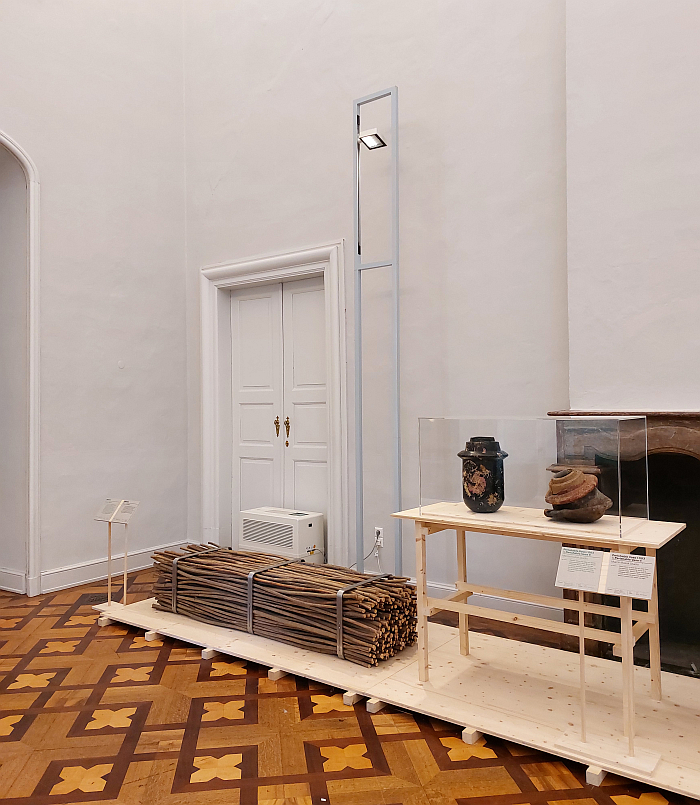
The bench Sheaves by Steven Banken (l) a work we first saw in Eindhoven in 2010 and which remains to this day one of those reference projects we always return to when we lose faith in design, and two Perishable Vases by Marcin Rusak, and which we may or may not have seen in context of Marcin Rusak – Nature of Things II at the Horta Museum, Brussels in 2018, as seen at Plant Fever. Towards a Phyto-centred design, Schloss Pillnitz, Dresden
A period when, as Plants as Passion neatly elucidates, European society was, arguably for the very first time, actively interested in the detailed, fundamental, study of plants; whereas in centuries past plants were known by, for example, the dyes they enabled, their medicinal properties, their physical properties or how they tasted, and if they were likely to kill you, or your enemy, the developing fever, to stay in the prevailing vocabulary, of scientific discovery in the course of the 18th century, that fever of that age of enlightenment and reason across Europe, meant that that no longer sufficed, we needed to know more. And thanks to the passions of Friedrich Augusts I and II Schloss Pillnitz became a location of botanical and horticultural discovery.
And thus a location of the classification of plants, a well-thumbed and richly annotated 1754 edition of Carl Linnaeus’ Genera plantarum, that key work in the (hi)story of plant classification, helping underscore not only the role the work of Linnaeus and his contemporaries played in the work of the Kings, and botanists and horticulturalists, of Sachsen1, but also helping one appreciate that through the work undertaken on the banks of the Elbe — the curators note that Friedrich August I introduced, and thereby studied, documented, some 4,300 plant species to Pillnitz, Friedrich August II a further 16,000 — Schloss Pillnitz actively contributed to the development of the formal classification of plants in the 18th and 19th century, and for all actively contributed to the popular establishment of the formal systematic classification of plants.
A classification, a scientific systematic classification, of plants that, as with all scientific classification systems of naturally occurring variation, be that, for example, colour, noise, non-human animals or human animals, organises and institutionalises that which is being classified, denies it its inherent character and nature, places it in rigid frameworks and structures: alters our perspective on and understandings of and relationships with the thus systemised. And in doing such, invariably, makes them something that can be readily employed and exploited for human activity, more conveniently employed and exploited for human activity than in their non-systematic identity; as noted from Organizing Things at the Werkbundarchiv – Museum der Dinge, Berlin, the etymology of “organize” can be traced to the ancient Greek, ὄργανον, organon: organ, instrument, tool.
And a utilisation and exploitation enabled by the instrument, tool, of scientific systematic classification which, not least in context of the wider rationalisation, optimisation and standardisation, and the simultaneous and closely related intensifying of industrialisation and commercialisation in the course of the late 19th and early 20th centuries, increasingly saw plants used and abused and exploited by industry and by high intensity, monoculture, agriculture.
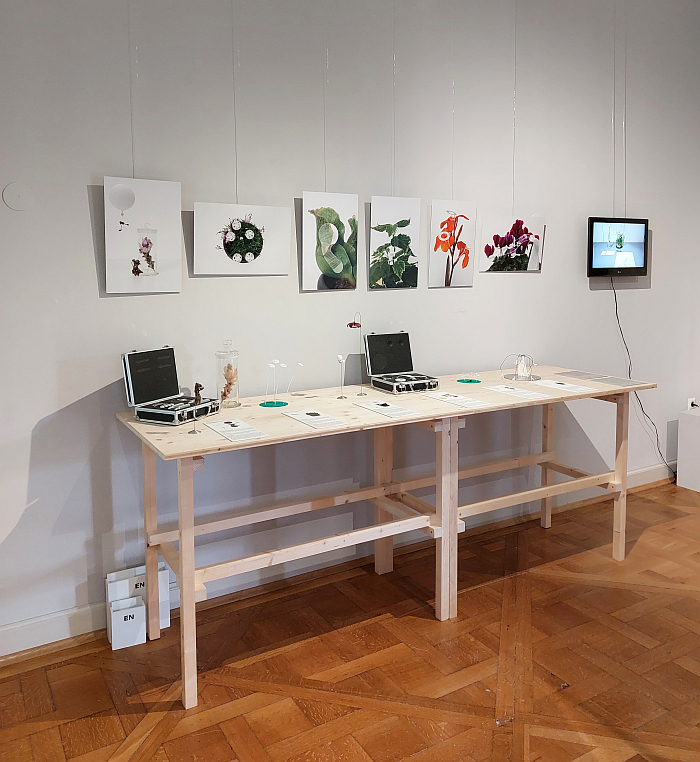
The Plant Sex Consultancy by Pei-Ying Lin, Špela Petrič, Dimitris Stamatis & Jasmina Weiss, a series of erotic aids to help plants whose sex life has been disrupted, hampered, by climate change or other human activity, as seen at Plant Fever. Towards a Phyto-centred design, Schloss Pillnitz, Dresden
In addition, through the work carried by Friedrich Augusts I and II and their many European contemporaries there arose, if one so will, an objectification of plants, plants became valuable and desirable not because of what they produced or enabled but because of what the were, their form, their colours, their origin, they began to be understood as pretty rather than as useful, certain plants would have been all over Instagram in 1850 while others would have been roundly ignored as fundamentally uninteresting; the aforementioned 600 nurseries in Dresden in ca. 1900 can certainly be considered a symptom of a contemporary plant fever. Not an unknown fever, one must only think of the Tulip Mania of the early 17th century to understand that such plant fevers have long and regularly gripped Europeans; but a 19th century fever which in context of its relationships to the evolving social and economic realities of the period, and their ongoing influence in European societies, means it is a fever that lingers to this day.
And a fever which through its defining certain plants as interesting and others as not, some as worth viewing and others as not, alongside the industrialisation of plants enabled by scientific classification and breeding, a denaturalising of plants by science and industry, that, arguably, ¿inarguably?, contributed to the development of what James Wandersee and Elisabeth Schussler labelled Plant Blindness2, a condition in which, according to Wandersee and Schussler, the sufferer fails not only to see but fails to appreciate plants, a condition that in many regards can be understood as a vicious circle: people have less interest in plants and so notice plants less and so have less interest in plants an so notice plants less and so ad nauseam ad infinitum.
And thereby a systematic classification of plants, a scientific study of plants, an objectification of plants, an excitement, mania, frenzy that, one can argue, helped facilitate that shift in human relationships with plants from that of yore when plants were known by, for example, the dyes they enabled, their medicinal properties, their physical properties or how they tasted, and if they were likely to kill you, or your enemy, that shift from an innate, direct, relationship to more abstract, impersonal relationships; and thereby helped facilitate the development of the sickness, unwellness, pyrexia as expressed by individual plants and the wider environment. If one so will contributed to the human-plant relationship turning toxic. Contributed to our Garden of Eden becoming a tortured hell.
Which obviously wasn’t what the likes of Friedrich Augusts I and II, or indeed Carl Linnaeus, wanted, or envisaged as possible. We imagine they’d be utterly shocked and appalled if they knew. Nor is it a direct consequence of the pursuit of science, rather of that idiosyncratic manner in and via which the human species in its infiniite wisdom understands and applies the fruits of scientific pursuit.
And which very obviously raises the question, if that excitement, mania, frenzy of the 18th/19th century can be considered a contributing factor to the sickness, unwellness, pyrexia of today, what of our contemporary plant fever? How will, could, our contemporary plant fever impact in coming decades on plants and the environment?
???
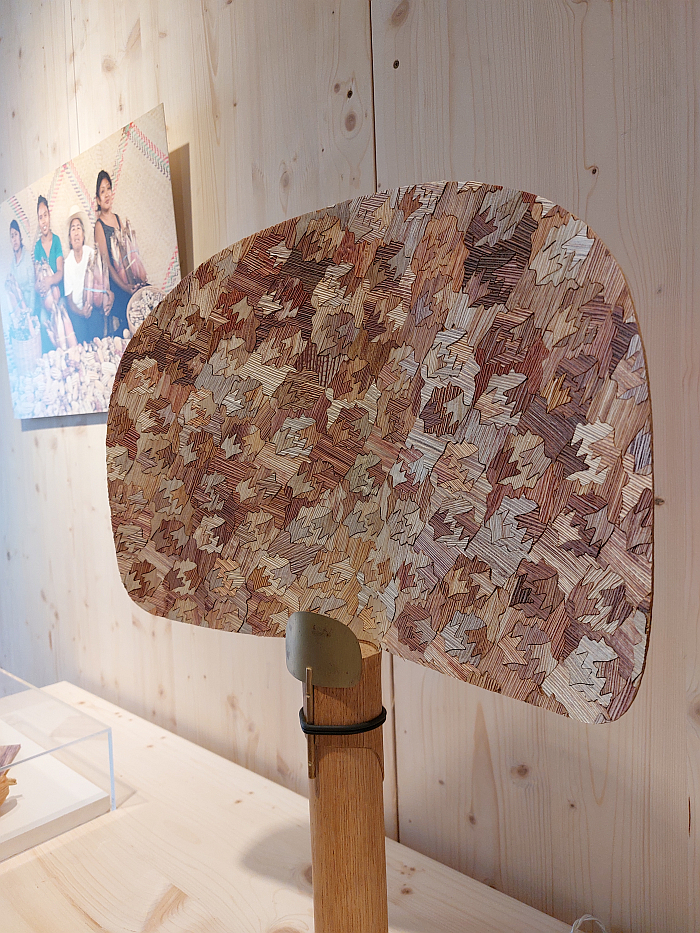
Totomoxtle by Fernando Laposse a veneer made from the variously coloured husks of ancient Mexican maize varieties as a means of encouraging biodiversity and providing an alternative income source for smallholders, as seen at Plant Fever. Towards a Phyto-centred design, Schloss Pillnitz, Dresden
No-one knows.
Obviously. We can’t see into the future.
We can’t.
But we can see into the past, be aware of what has come before, study and analyse what has come before, including in context of what is.
And in enabling such the three Plant Fever showcases allow one to appreciate that while the contemporary excitement, mania, frenzy may be readily comparable with that of the late 18th/early 19th centuries, there are a few fundamental differences.
The primary one being, for us, attitude.
Back in the day the scientific study of plants was, one can argue, primarily a component of the human species attempts at dominating, mastering, controlling plants, itself a component of the human species long held dream of dominating, mastering, controlling nature, a position that was widely and unquestioningly accepted, and which the overwhelming majority, we’ll argue, supported and thought was all for the best.
Plant Fever via the nature of the discourses it initiates and the insights it enables allows one to appreciate that we’ve moved on from that……. no, stop, that’s not quite right, allows one to….. allows one to….. to appreciate that we are in the slow, painful, process of moving on from that, that increasing numbers of us increasingly understand plants not only as important partners without whom life on earth would be impossible, or as Stevie Wonder so eloquently, deliciously, phrases it,
“But if you ask yourself where would you be
Without them you will find you would not“3,
but we increasingly understand that we can learn from plants, and learn more from plants than just perceived rules of beauty that was one of the many foci of the aforementioned Art Nouveauists. Or perhaps put another way, we are increasingly relearning that plants are more than just decorative.
Altering perspectives on plants that can be approached through the juxtaposition of the projects, positions and arguments of the 18th/19th centuries as presented in the Neue Palais with the contemporary projects, positions and arguments via which the discourses in the Wasserpalais are undertaken in context of plants as resources, plants as allies and plants as pets… no, not weird. Think, for example, of office plants: whereas back in the day the occasional, isolated, plant pot may have existed on a desk by way of decoration, or an occasional, isolated, yucca or monstera or potted palm may have stood in the corner for……. for whatever the reason of such is and was, today plants in offices are increasingly integral components of not just the furnishings and the atmosphere but also of the team.
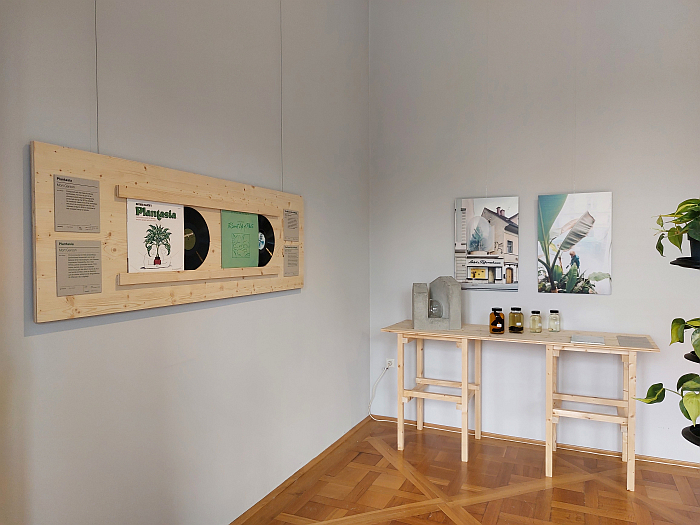
Mother Earth’s Plantasia by Mort Garson and Journey Through The Secret Life of Plants by Stevie Wonder in discourse with Oasis No.8 by Markus Jeschaunig, as seen at Plant Fever. Towards a Phyto-centred design, Schloss Pillnitz, Dresden
And altering perspective that can also be appreciated in mischer’traxler studio’s intervention in, not inappropriately, the Jugendstil room of the Kunstgewerbemuseum’s Bergpalais residence, an intervention that, if one so will, is a fourth component of Plant Fever, and which, amongst other projects, introduces their so-called Themis Lab, an attempt to develop methodologies to allow ecosystems to participate in discourses and dialogues on the future of societies and the planet, if one so will an attempt at the development of the Ecocracy as a viable, future-resilient form of power administration. And which also envisages, inherently demands, recognising nature, components of the natural environment, as juridical persons with legal rights and responsibilities; thoughts which remind of the discussions presented in Garden Futures. Designing with Nature at the Vitra Design Museum, Weil am Rhein, on, for example, the rights awarded the Whanganui river in New Zealand or the unsuccessful attempt by activists in Chile to enshrine a legal standing for nature in the constitution, and which just a few short years ago would have been dismissed out of hand as hippy nonsense on stilts, but which today, whether or not you agree with the positions, the greater many would concur with the need to debate and discuss such claims.
Or put another way, as Plant Fever allows one to appreciate, we’re not as blind to plants today as we have been in recent decades and centuries. That blindness may indeed have been but a social cataract which is slowing being removed.
The question is, will that help us see better? Will that help create a greater equity between the human and the plant worlds, allow for a relieving of the the sickness, unwellness, pyrexia? Or will our contemporary excitement, mania, frenzy mearly unveil new ways via which we can torment plants and the environment in the name of human progress? Will the continuing compulsion to optimisation and/or our ongoing search for novel materials for consumer goods and/or our ongoing search for answers to the challenges of feeding and housing an ever expanding global population and/or our ongoing deliberations on ever newer and more ridiculous modes of mobility and/or society’s fever for new trends, that cultural Groupthink that sees everybody doing something, consuming something, eating something because they believe everyone else is rather than because they need to, mean that the sickness, unwellness, pyrexia simply takes on new forms? Will the human ego mean that the sickness, unwellness, pyrexia simply takes on new forms?
???
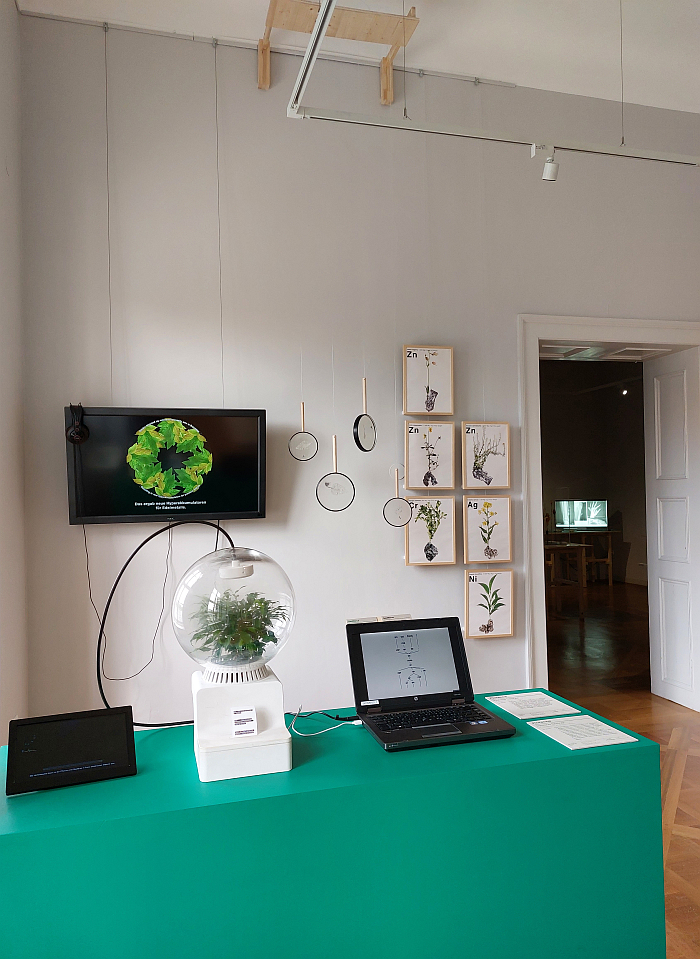
Florence by Helene Steiner which seeks to develop a human-plat communication interface, & GeoMerce by Gionata Gatto and Giovanni Innella which proposes uses plants to “mine” for heavy metals, as seen at Plant Fever. Towards a Phyto-centred design, Schloss Pillnitz, Dresden
No-one knows.
Obviously. We can’t see into the future.
We can’t.
But we can contribute to that future.
Back in the day questions of our relationships with nature were not only approached on the basis of less facts, experiences and insights than we have at our disposal today, but were the preserve of a very small and select group of individuals, today we are all empowered to contribute. And Plant Fever very much admonishes we all make use of that opportunity.
For their part the Plant Fever curators studio d-o-t-s, a.k.a. Laura Drouet & Olivier Lacrouts, present their seven point manifesto for going forward, a manifesto that includes positions such as, for example, a boycott of monoculture in all its manifestations, consuming less plant based materials such as, for example, furniture from virgin wood, or an increased focus on design with plants, on letting plants guide and inform the design of our systems and societies, a position which echoes through Garden Futures at the Vitra Design Museum. And also includes the demand that we stop “the war on invasives”; one the hand an admonishment that in an age of climate change species from one region naturally adapted to the new realities in another region can be beneficial in helping that second region adapt and adjust, and on the other a reminder that the definition of plants as good or bad, right or wrong, native or foreign, desirable or undesirable, is not only a truly excellent metaphor we should all reflect on more often than we do, but is also one of those concepts that we’ve taken on from previous generations, not least from our 18th and 19th century forbearers, and which, to quote a Le Corbusier, is one of those customs that has turned into a habit4, with all the restricting, encumbering, blinkering, consequences that has on our view of the world and the possibilities of the individual and society. And thus something we really need to move on from. Which, yes, is also a continuation of the metaphor.
A manifesto that while you don’t have to agree with every position, is an excellent place to begin formulating your own positions on the future relationships between the human world and the plant world, between the human world and the natural world.
Formulating your own positions on preventing the human species’ new fever for plants turning into a new fever of plants.
Or at least offering the hope of such.
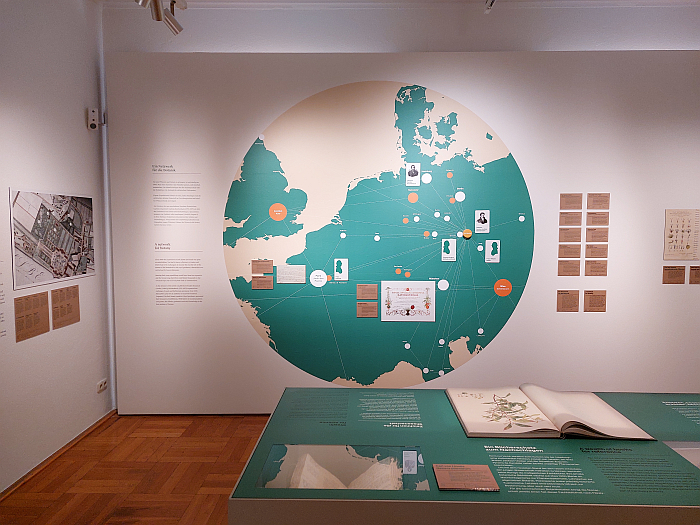
A map of the Schloss Pillnitz networks in the 18th and 19th centuries, as seen at Plant Fever. Towards a Phyto-centred design, Schloss Pillnitz Dresden
A spatially and thematically expansive presentation Plant Fever, aside from the easy and entertaining manner in which it allows access to a myriad positions, discourses and discussions, is also, and much like The Bigger Picture: Design – Women – Society at the Gewerbemuseum, Winterthur, an excellent example of extending an existing exhibition, an excellent example of how local narratives and (hi)stories can be added to an existing presentation and thereby both bring new insights and perspectives to the original and also expanding and deepening the scope.
An expanding and deepening of the scope, an adding of new insights and perspectives, achieved by Plant Fever not least through the integration of the Schloss park and gardens into the presentation as a living, breathing example of the varied and various forms of expression of historic excitement, mania, frenzy, and also as a quiescent, wheezing, rasping example of the contemporary sickness, unwellness, pyrexia. The latter arguably best exemplified by the missing copper beech on the edge of the Lustgarten: an areal that was once framed by two copper beeches, before one fell victim to fungal infection, a common enough event, and in itself not automatically problematic; but an infection which on account of the beech’s increased stress through climate change meant proved fatal. Plants as with humans react worse to illness if intrinsically unhealthy. And so now only one copper beech stands watch over the Lustgarten, very much aware that its sibling’s fate could one day be its.
And a missing copper beech which is also a component of contemporary considerations and discussions on historic gardens such as Pillnitz in an age of climate change. A discussion on the future of such gardens that is also component of Plant Fever, and which for us was neatly highlighted by the sight of two Schloss Pillnitz gardeners on their knees weeding in the Charmilles, that area of hedge-bordered gardens, and which in causing us to question why anyone should spend three years training to become a gardener to then spend your days actively ruining your body picking out plants that convention defines as bad, wrong, foreign, undesirable, subsequently caused us to reflect on studio d-o-t-s manifesto and the call to stop “the war on invasives”. For what are weeds if not invasives in our gardens of preconception, convention, ideal, control. Thoughts reinforced a few days later in a different historic garden, one we understand is currently having staffing problems — see spending three years learning a profession to then spend your days actively ruining your body pulling healthy plants out the ground, for possible reasons — and where some of the rose beds were so densly populated by non-roses that terming them rose beds was technically incorrect. But are rose beds that are a majority non-rose perhaps the better option than rose beds that are 100% rose? Is, given our contemporary realities and problems, a perfectly manicured garden something we can afford? Something we should afford? Or is it something we have to move on from, should, must, move on from? Should we not embrace all those species that choose to grow in our gardens, can grow in our gardens without us creating any more problems for ourselves and our environment? Should, must, gardens like Pillnitz look the same in the future as they did in the past, or is it not necessary and important that they change? Were such gardens not established as reflections of contemporary society and culture and positions, and should they not remain such rather than being reflections of the past? Should the “English” garden, the “Chinese” garden and the palm house of previous generations not cede to a “climate” garden, a “haphazard” garden, a “natural” garden? What is the role and function of gardens such as those in Pillnitz as we move through the 21st century? Are there not better and more meaningful uses for humans’ faculties and centuries of evolution and education than weeding?
And an expanding and deepening of the scope, an adding of new insights and perspectives, also achieved via the manner in which Plant Fever allows access to considerations on the links between 18th and 19th century botanical, horticultural, research and colonialism; a subject not directly approached in Plant Fever, but one which is very present throughout Plant Fever, for all in Plants as Passion and in the gardens themselves, showcases which also underscore the many possible access points Pillnitz offers for that more direct approaching. And of which, aside from the many expeditions to far flung lands Friedrich Augusts I and II financially contributed to and from which they received many plants, and one would imagine one or the other non-plant trophy, the most elegant form, literally, for approaching links between gardens such as Pillnitz and colonialism is the so-called Pillnitz Camellia, a Camellia japonica that arrived in Pillnitz in 1801 and which we more than suspect can, both directly and indirectly, tell some very fascinating, and most informative, tales. If asked. Which as far as we are aware no-one has thus far. Preferring as we all do just to look at it. After 200+ years we could at least ask it what its real name is.
Links between 18th and 19th century botanical, horticultural, research and colonialism, that is just one of several possible future threads of enquiry that Plant Fever opens, threads, or at least some of which, the current residents of Schloss Pillnitz, if we’ve understood correctly, hope to follow in context of the 2023 edition of the Kunstgewerbemuseum’s Design Campus Summer School which is being staged very much in context of Plant Fever, and under the direction of studio d-o-t-s, and which thus should, one would hope, allow for the development of new projects, projects in context of and arising from Schloss Pillnitz past, present and future, that should, can, further deepen and expand Plant Fever and thereby allow Plant Fever to become an even more instructive institution than it is. And for all allow Plant Fever to contribute even more than it currently does to the urgent discourse on the development of a future-resilient society reflective of and responsive to the needs, demands, comforts of not just human animals, but non-human animals, plants and all with whom we share this planet.
Plant Fever. Towards a Phyto-centred design is scheduled to run at Schloss Pillnitz, August-Böckstiegel-Straße 2, 01326 Dresden until Tuesday October 31st.
Full details can be found at https://kunstgewerbemuseum.skd.museum
In addition a bilingual French/English catalogue is available.
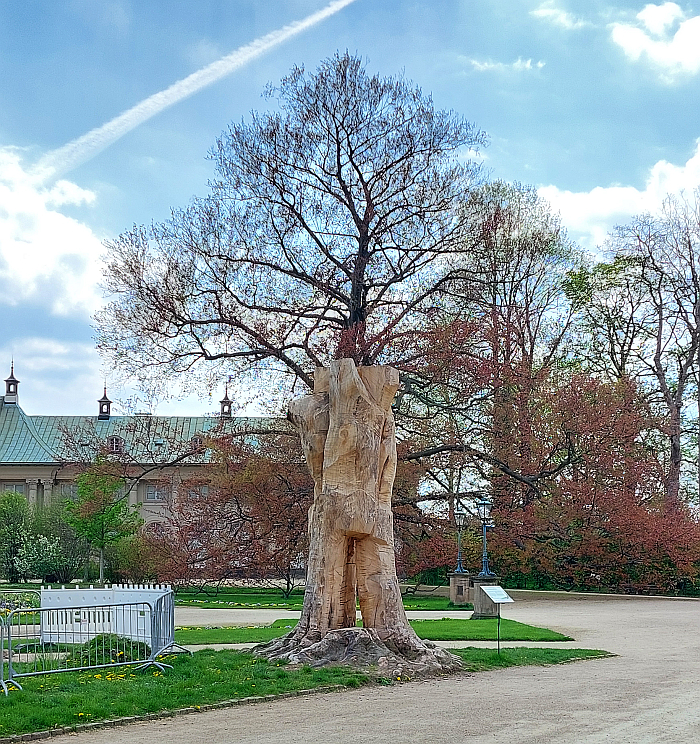
The remains of the dead copper beech, and behind it the remaining, solitary example, as seen at Plant Fever. Towards a Phyto-centred design, Schloss Pillnitz, Dresden
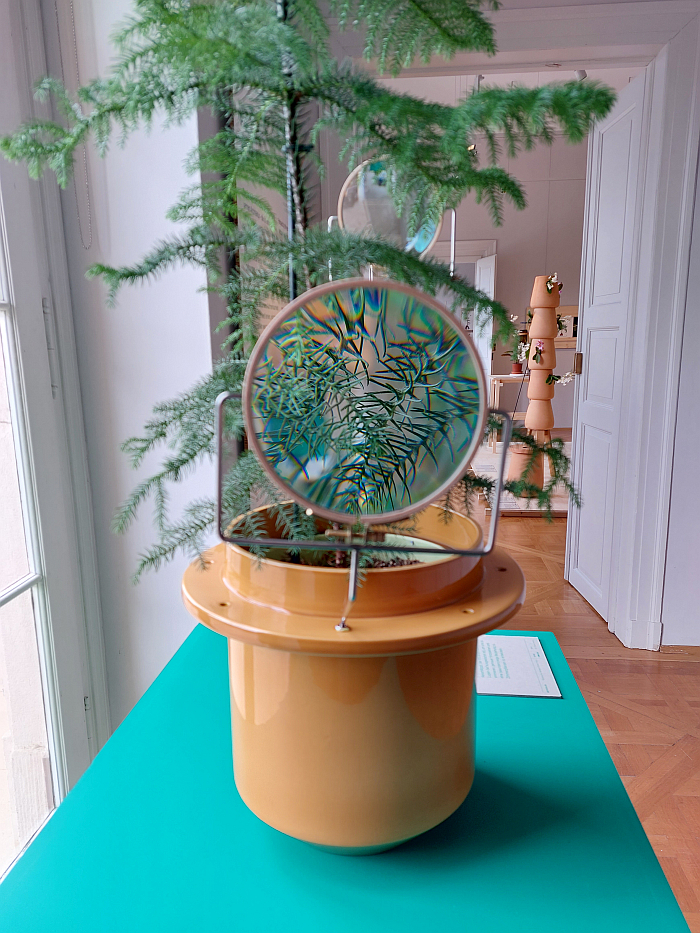
The Phytophiler by Dossofiorito a.k.a. Livia Rossi and Gianluca Giabardo, a plant pot with a magnifying glass to allow you to get closer to the plant, as seen at Plant Fever. Towards a Phyto-centred design, Schloss Pillnitz, Dresden
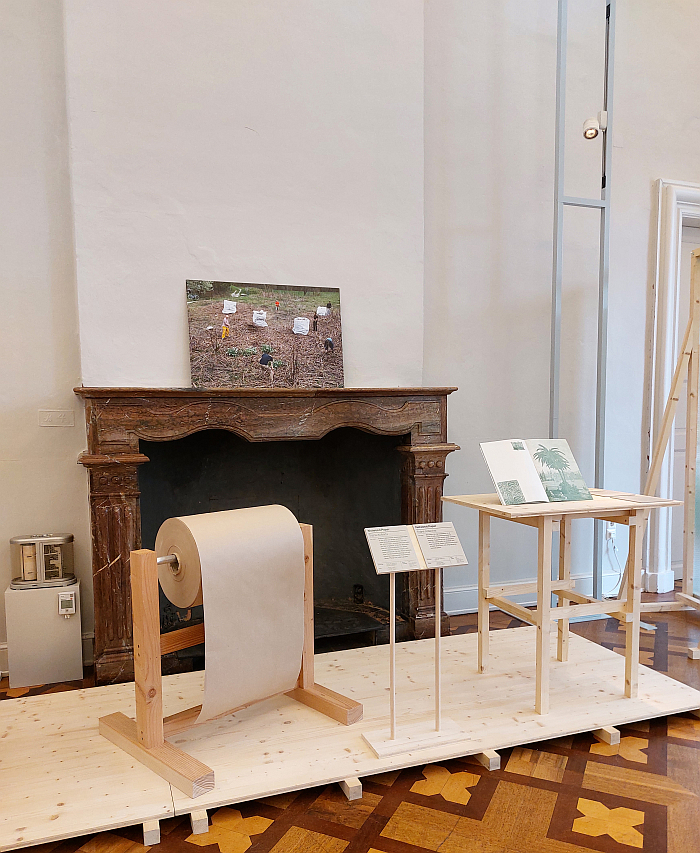
Notweed Paper by Trajna collective, paper from Japanese Knotweed, which also confirms that Knotweed is not (necessarily) a weed, as seen at Plant Fever. Towards a Phyto-centred design, Schloss Pillnitz, Dresden
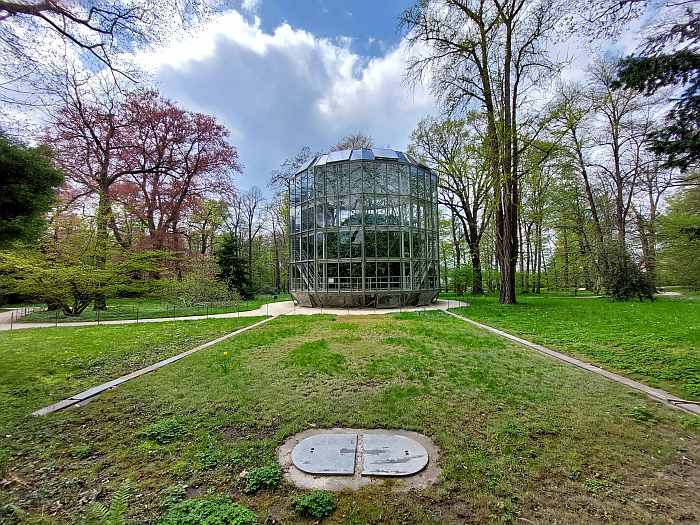
The Pillnitz Camellia inside its transportable greenhouse…yes, we there a while ago, the Camellia is now standing in the open air
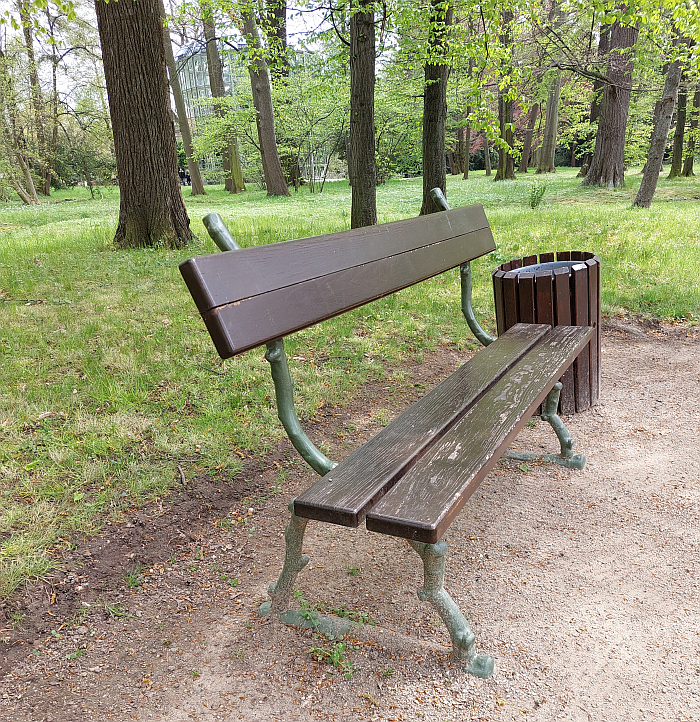
An alternative take on inspiration from nature as demonstrated by a bench in the Schloss Pillnitz garden, and which, yes, is relatively kitschy but does also, we’d argue, echo the sort of rustic look that the 17th century Forrest Chairs, those, in all probability, early Windsors would have had, and so kitschy but informative……
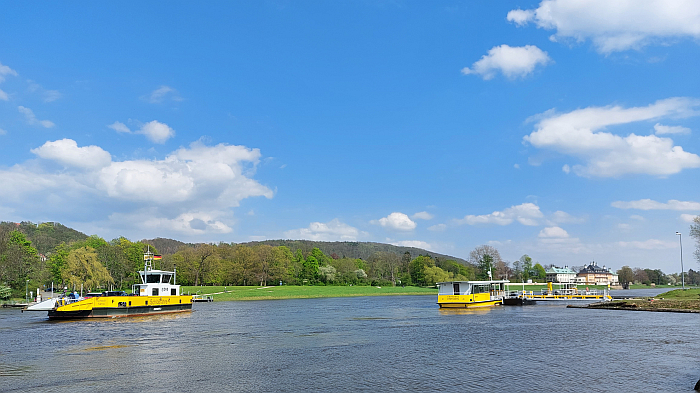
Might not be as opulent as the gondolas of yore, or take you to the Wasserpalais staircase, but is affordable for all…. and the water route is still the best way to Pillnitz
1. It is however interesting to note that the map showing the network in which Schloss Pillnitz existed doesn’t connect to Uppsala, Sweden, where Linnaeus worked. If there wasn’t a connection or if depicting it was going to be graphically problematic and so it was left out, we no know…….
2. James H. Wandersee and Elisabeth E. Schussler, Preventing Plant Blindness, The American Biology Teacher, Vol. 61, No. 2 February 1999, page 82ff
3. Stevie Wonder, The Secret Life Of Plants from Journey Through The Secret Life of Plants, Tamla Motown, 1979 The album along with Mort Garson’s 1976 album Mother Earth’s Plantasia feature in Plant Fever and both were the soundtrack to the writing of this post……
4. see, Le Corbusier, The Modulor: A Harmonious Measure to the Human Scale Universally Applicable to Architecture and Mechanics, Harvard University Press, 1954, page 15
Tagged with: Dresden, Kunstgewerbemuseum Dresden, Plant Fever. Towards a phyto-centred design, Schloss Pillnitz
